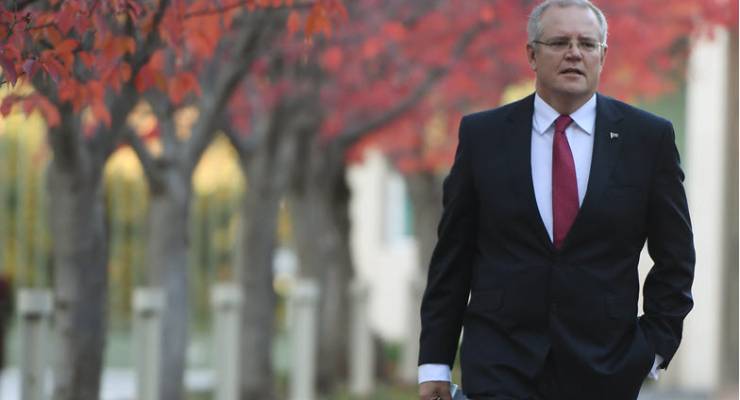
Given the next election is more than two years away, the Turnbull government seems remarkably determined to ensure that tonight’s budget yields the greatest possible boost to its immediate electoral fortunes.
Under normal circumstances, this would be the optimal time to pile on whatever nasties the government has planned for its second term in office, leaving the bribes and goodies to be dispensed as close as possible to election day.
Instead, the Prime Minister and the Treasurer have spent the last month walking back from tough talk on debt and deficits and announcing initiatives targeted at its most sensitive areas, namely education, health and housing affordability.
The first two in particular have been perennial difficulties for the Liberals but were particularly problematic at last year’s election — especially in the case of health, which loomed large in Liberal efforts to apportion blame for their disappointing performance.
For such reasons has the government foreshadowed an unwinding of the freeze on Medicare rebates, even at a cost of billions of dollars to an overloaded budget, as well as cleverly purloining the Gonski brand for its schools funding package.
Another electorally driven priority is Western Australia, where the calamitous state election result in March is being matched by barely less disastrous federal polling — the latest example being a poll suggesting Social Services Minister Christian Porter will lose his seat of Pearce on a 6% swing, which was conducted for a Labor-aligned client and published today in the Financial Review.
The federal government has accordingly agreed to stump up $1.6 billion for roads and rail, including a big political fillip for the new state government in the form of funding for its flagship Metronet rail project.
In abandoning the textbook strategy for managing the three-year electoral cycle, Malcolm Turnbull is once again illustrating his weak position amid a divided party and urgent need to recover authority through a stronger showing in the polls.
Compounding the difficulty is the rod he created for his own back by invoking Tony Abbott’s 30 successive Newspoll defeats as a rationale for his leadership challenge, with his own losing streak currently sitting at nine.
As it happens, the most recent polling has provided a glimmer of evidence that he may already be turning the corner, despite Tony Abbott’s efforts to emulate Kevin Rudd’s achievement in persistently smothering any signs of recovery that occasionally emerged for Julia Gillard.
For the first time since the election, the aggregated polling trendline is moving just slightly in the Coalition’s favour, after being stuck around 53-47 in the wake of a steady decline in fortunes late last year.
Even if this reflects Turnbull’s efforts to game Newspoll with popular announcements timed immediately before its field work period, it can hardly be doubted that the rot has at least stopped, and that the Coalition no longer appears headed for the terminal depths plumbed by Gillard through most of Labor’s second term.
Further evidence of the government’s competitiveness is provided by the leaders’ personal ratings, notwithstanding that neither leader has been covering themselves with glory of late.
Labor’s lead on voting intention has not been reflected in Bill Shorten’s personal approval and preferred prime minister ratings, with the former tracking downward at precisely the same rate as Turnbull’s, and the latter running straight as a die since the election.
While these measures are often derided as “beauty contests”, approval ratings in particular have done a good job in predicting election results at least since John Howard’s win in 1996 (Paul Keating’s excoriating campaign against John Hewson’s proposed goods and services tax in 1993 got the job done at the ballot box, but it didn’t do his personal appeal any favours).
At each of the last eight elections, the party whose leader had the higher approval rating in the final pre-election Newspoll went on to win the two-party preferred vote, by margins well in proportion to the size of the lead.
It can be hypothesised that the intensive focus on the leaders during an election campaign causes voters to prioritise their perceptions of them when deciding how they will vote in earnest, regardless of what the polls might happen to say about voting intention mid-term.
On that basis, Bill Shorten’s weak numbers leave ample room for doubt as to whether he would have the firepower to get Labor over the line against a government that in any way had its act together.
The response to tonight’s budget will go a long way towards determining how true that will be of the Turnbull government in another two years’ time.








Give it up, William…most people I know can’t wait to be rid of this putrid government. They either don’t believe anything they say, or have given up listening to Turnbull completely.
Labor doesn’t only have Shorten…it has a first class front bench/team, a vision for the future, and the policies to get us there.
No contest…the polls won’t change over the next two years, but hopefully the government will collapse completely before then so we can have an early election!!
With due respect to CML’s advocacy of her great-great-great- etc nephew gumBoil Shlernt, both he & Talcum are in the unique position of being each others best asset